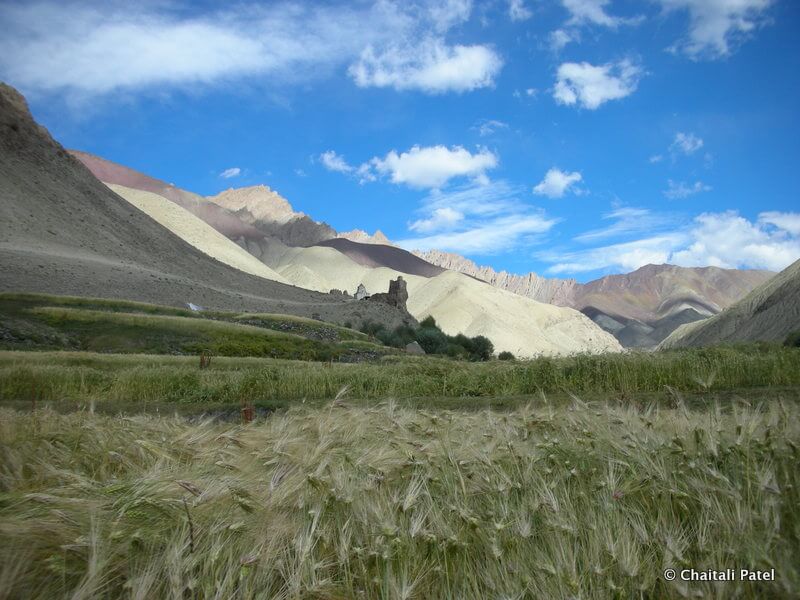When we were planning our trip to Ladakh, what drew us to the idea of doing a homestay, was the simple yet powerful concept behind a homestay. The Snow Leopard Conservancy encourages and trains local families to welcome tourists into their houses for a very nominal fee. The money thus collected serves as an additional income for the local people. This additional income not only increases the communities’ stake in protecting wildlife but also offsets the losses that these villagers incur due to livestock depredation by snowleopards.

Completely sold on a home stay, we managed to combine it with our two day trek in the Rumbak Valley. Although a relatively easy trek, the altitude and the intense heat made it an arduous task. One normally does not associate heat with the mountains, but Ladakh being a cold desert, experiences extreme weather conditions.
The trek itself was a gradual climb and our path was along a river, which apart from providing a picturesque backdrop provided a welcome relief from the heat. The first signs of the village were fields that gradually grew in size as we climbed further up. Our first and much needed pit stop was at this little shop that was some white, canvas stretched across a pole to cover a small wall that was the enclosure. Luckily for us we managed to find some space and got our hands on some hot chai and biscuits. It was a struggle to get ourselves up as we did have to walk a little more to reach the village we were staying in.
The village was nothing but a collection of a few brick houses, spread out, overlooking the fields. It had this deserted look, as most people were out in the fields working. The houses are made of brick and from inside the walls and the floor are plastered with mud. Once inside a narrow corridor opens into a big room that housed the kitchen and the common area where the family have their meals and watch TV. Ladhaki kitchens are very interesting and maybe the one distinct characteristic that distinguish their homes from any other. They have a variety of brass and steel vessels that are all displayed. Actually they display almost all vessels that they have, even if it is an empty Amul tin. The prosperity of the family is judged by their kitchen and the number of vessels on display. The lady of the house made us some gur gur chai or the traditional Ladakhi butter tea. It’s made of butter and is salty, almost like a soup, but it keeps the body warm and is a great source of energy.
Having met our family and wanting not to disturb them while they performed their everyday tasks, we ventured out to the farms. There were baby yaks that had to be taken for a walk and grass bundles to be tied.
Stating that every mountain in Ladakh is beautiful and different from the other is stating the obvious, but one cannot imagine that masses of rock and soil can look so spectacular. Add to it the clear deep blue skies and a touch of green and nothing can make it look any better.
Dinner was a simple affair, comprising rice, dal, and potato subzi. We were also offered some Chang or the local alcohol that has a distinct fermented taste.
We were armed to deal with no electricity, with our sophisticated torches from the city, but were completely unprepared to deal with a typical Ladakhi toilet. Ladakh being a cold desert, water is a scarce resource. Their toilets consist of a raised room with a pit in the floor. Once done you just have to push some sand into the pit. What gets collected down below is used as manure. Though shocking and maybe even revolting to a city dweller, the whole process is extremely eco friendly.
The next day started early for us. The villagers start work at day break and come back to their homes for breakfast by around nine. Breakfast consisted of fresh Ladakhi bread, which is like a roti and made on a chula (traditional Indian stove) fired by dung cakes.
To experience what a simple life is one has to go and live in a village. But simple does not mean easy. Village life is very tough and villagers work extremely hard to earn a living. But yes it’s uncomplicated as compared to our hectic, on-the-move city life, where unknowingly more often than not we miss out on the finer things in life.
***
This article was published under the Travel section of Deccan Chornicle on the 29th of November 2009.

No Comments